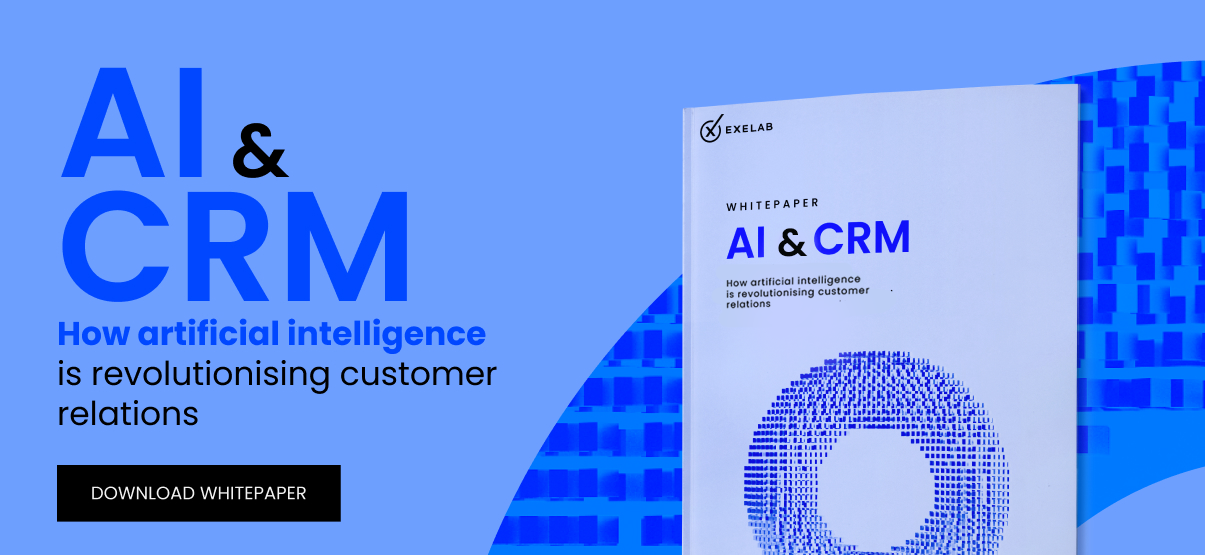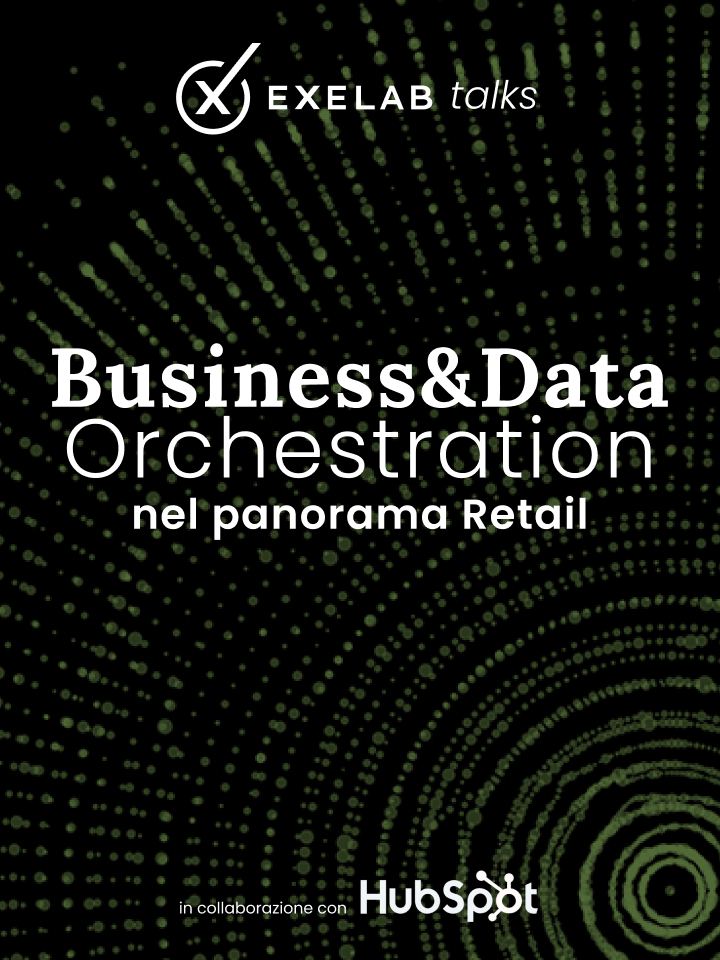
The Future of Loyalty in the Data Era
Increasingly sophisticated and personalized customer experiences...
Read moreInsights
Go to the BlogIn primo piano

The Future of Loyalty in the Data Era
Increasingly sophisticated and personalized customer experiences...
Read moreEnterprise Solutions
Recent Publications
Whitepaper

How artificial intelligence is revolutionising customer relations
Download the WhitepaperExtra
A new horizon for CRM
Automation and integration: apps

100% digital, fast and paper free processes
A new standard based on AI and HubSpot
Integrated and optimized e-commerce management with HubSpot
Exelab World
Where ideas and innovation meet
Texts to meet tomorrow's challenges
Discover our insights: visit the blog
Latest updates
Insights
Go to the BlogIn primo piano

The Future of Loyalty in the Data Era
Increasingly sophisticated and personalized customer experiences...
Read moreAbout Us
Innovation, excellence, technology: at Exelab we design the future of business processes
Exelab and The Client Group: an operational synergy to raise customer experience to the highest level
Careers
We are always looking for talent ready to make their mark: explore our opportunities
We're hiring!Exelab is an official partner of


Events
Discover our EventsMost Recent Event

Solutions
Enterprise Technology
HubSpot
Discover
About
Solutions

Exelab Solutions
Insights
Go to the BlogIn primo piano

The Future of Loyalty in the Data Era
Increasingly sophisticated and personalized customer experiences...
Read moreEnterprise Technology

Enterprise Solutions
Recent Publications
Whitepaper

How artificial intelligence is revolutionising customer relations
Download the WhitepaperHubSpot

Extra
A new horizon for CRM
Automation and integration: apps
Discover


100% digital, fast and paper free processes
A new standard based on AI and HubSpot
Integrated and optimized e-commerce management with HubSpot
Exelab World
Where ideas and innovation meet
Texts to meet tomorrow's challenges
Discover our insights: visit the blog
Latest updates
Insights
Go to the BlogIn primo piano

The Future of Loyalty in the Data Era
Increasingly sophisticated and personalized customer experiences...
Read moreAbout

About Us
Innovation, excellence, technology: at Exelab we design the future of business processes
Exelab and The Client Group: an operational synergy to raise customer experience to the highest level
Careers
We are always looking for talent ready to make their mark: explore our opportunities
We're hiring!Exelab is an official partner of


Events
Discover our EventsMost Recent Event


At the beginning of this year, Gartner published a study for CSOs, incorporating data and aspects that should not be underestimated in the B2B sales process.
Among these, the data highlighting a significant reduction in the intervention of sales agents to finalize a sale stands out — with 72% of purchases completed entirely online and 83% of clients preferring this method to access a product or service.
This dynamic, however, has highlighted another fact: B2B clients who purchased online are 22% more likely to regret their purchase, leading to what we call purchase regret.
Purchase regret can stem from deficiencies in value (actual quality of the product or service compared to its price), communication (incomplete or unclear information, with little emphasis on the objectives driving a client's purchase), and technology (non-functioning or sluggish purchase flows).
Given that, as per McKinsey, 20% of clients would spend over $500,000 on non-physical purchases, understanding how to overcome these gaps is crucial.
Although still a subject under study, we can start by examining the three aforementioned areas.
In a publication about our continent's market, CBI (a department of the Dutch Ministry of Foreign Affairs) stated that value is more critical than price. The study on market trends and opportunities in Europe highlighted the advantages companies targeting a niche or offering very vertical services have. Such companies garner a more specific understanding of their clients, sector, and market, opening the possibility of emphasizing the quality of service and purchase experience. Given that acquiring clients is essential but retaining them even more so, understanding and information about one's audience remains paramount.
However, achieving substantial results is improbable without an adequate communication strategy and technology that enables this knowledge process.
Especially for B2B sales (given the heightened attention and experience during purchase), communication should aim to add value to the client.
Gartner emphasizes content that tests users' willingness to purchase and prepares them to make informed decisions regarding not just the service but also the sector. Text contents accompanying digital funnels should, therefore, be informative enough to encourage users to reflect on their goals and needs.
Simultaneously, interface design should prioritize functionality. Many companies adopt minimalist and "clean" designs to help clients focus on content. The UI should be seen as a tool that reinforces brand identity, hence playing on trust and reputation.
However, communication loses its essence if the technological foundations supporting the digital sales journey are shaky. Simply put, if the purchasing steps malfunction, halt, or fail to engage the client, they won't buy.
Using technology to enhance digital funnels fundamentally serves two goals: facilitating customer purchases and understanding their behavior. Examples include recognizing a returning user on a standalone landing page to display a personalized message or discount, using chatbots to guide and inform clients throughout their journey, or triggering specific actions based on client behavior (assuming that previous client activity has been well-tracked and segmented).
On the flip side, sometimes developers are restricted by the technology in use—for instance, if a connection to a third-party system (like during payment) fails.
While there are still numerous instances where the digital purchase process is assisted or completed by an agent, B2B is increasingly incorporating entirely digital funnels.
A primary concern is post-purchase dissatisfaction, where the client finds the service different from its representation, overpriced, or of lesser value compared to industry standards. Simultaneously, this situation represents an opportunity for CSOs, who can tackle these challenges with richer and transparent communication and technological tools that offer flexibility to those crafting sales paths.
Technology should bridge the gap left by the absence of a sales agent, using real-time conversational tools and personalized messages while accurately monitoring client behavior and interactions in the sales funnel.
1: Chief Sales Officer Leadership Vision 2023, Gartner,
https://emtemp.gcom.cloud/ngw/globalassets/en/sales-service/documents/trends/2023-sales-leadership-vision-cso.pdf
2: Which trends offer opportunities or pose threats on the European outsourcing market?, CBI, Ministero degli Affari Esteri, 2022 sezione 7
https://www.cbi.eu/market-information/outsourcing-itobpo/which-trends-offer-opportunities#value-is-more-important-than-price